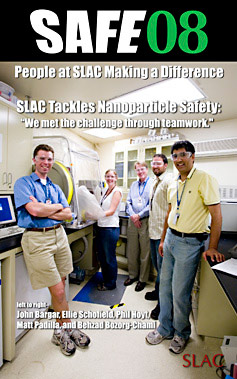
Handy Links
SLAC News Center
SLAC Today
- Subscribe
- Archives: Feb 2006-May 20, 2011
- Archives: May 23, 2011 and later
- Submit Feedback or Story Ideas
- About SLAC Today
SLAC News
Lab News
- Interactions
- Lightsources.org
- ILC NewsLine
- Int'l Science Grid This Week
- Fermilab Today
- Berkeley Lab News
- @brookhaven TODAY
- DOE Pulse
- CERN Courier
- DESY inForm
- US / LHC
SLAC Links
- Emergency
- Safety
- Policy Repository
- Site Entry Form

- Site Maps
- M & O Review
- Computing Status & Calendar
- SLAC Colloquium
- SLACspeak
- SLACspace
- SLAC Logo
- Café Menu
- Flea Market
- Web E-mail
- Marguerite Shuttle
- Discount Commuter Passes
-
Award Reporting Form
- SPIRES
- SciDoc
- Activity Groups
- Library
Stanford
Around the Bay
SAFE08: SLAC Tackles Nanoparticle Safety
 Nanoparticles are becoming more and more common in the laboratory landscape. As scientists make new and innovative discoveries with these fantastically tiny particles, they must also stay one step ahead of the potential risk that they pose. "Nanoparticle safety is a new world," says SLAC Environmental Health and Safety Division (ES&H) Industrial Hygienist Phil Hoyt. "There's a lot that hasn't been done before."
Nanoparticles are becoming more and more common in the laboratory landscape. As scientists make new and innovative discoveries with these fantastically tiny particles, they must also stay one step ahead of the potential risk that they pose. "Nanoparticle safety is a new world," says SLAC Environmental Health and Safety Division (ES&H) Industrial Hygienist Phil Hoyt. "There's a lot that hasn't been done before."
At the Stanford Synchrotron Radiation Laboratory (SSRL), John Bargar and his team are using high-intensity synchrotron X-rays to study the nano- and atomic-scale structures of uranium dioxide (UO2) nanoparticles made in soils by bacteria. They're looking for ways to enhance the stability and longevity of these natural nanoparticles in soil in order to help remediate uranium contamination in the ground.
As part of this project, Bargar and his team needed to prepare a significant quantity of dry uranium dioxide nanoparticles. The need to identify and mitigate potential hazards posed by these nanoparticles was immediately recognized as part of SLAC Integrated Safety and Environmental Management System (ISEMS) implementation.
"We came up against a challenge: how do we move the science forward and still be safe? And ultimately, we met that challenge through teamwork," says Bargar.
The team's first goal was to identify all possible hazards of dry uranium (as opposed to the wet form otherwise used). This dry form is unique in that it acts almost like a gas, remaining airborne for long periods of time. If inhaled, the particles could pass through cell walls and potentially cause damage to the human body. Uranium samples of any size are radioactive, and toxic if ingested. In this dry form, the samples are also mildly pyrophoric, meaning they have the potential to ignite spontaneously in the presence of air.
To keep the samples completely isolated from people and from atmospheric oxygen, they were kept in an airtight, clear plastic controlled-atmosphere anaerobic chamber. An entry chamber allowed samples to be introduced and removed from the box without contamination of the inner chamber by outside atmosphere or contamination of the outside atmosphere by uranium nanoparticles.
The group had to be certain that no uranium entered the outside atmosphere during such sample exchanges. Initial ISEMS planning efforts suggested that the most effective way to address this concern would be to install air filters on the exhaust lines leading away from the entry chamber, through which the entry chamber atmosphere was vented. This conclusion led to a re-examination of standard HEPA filtering technologies for nanoparticle control purposes and a review of Department of Energy guidelines on nanoparticle safetyŚconducted by the Bargar group in partnership with SLAC Radiation Protection staff Carol Morris and Jim Allan, and industrial hygienist Phil Hoyt. They found that standard HEPA filters were well adapted to catching nanoparticles, and installed these filters on the exhaust lines of the box.
Once the use of HEPA filters had been added to the safety plan, Bargar and his team submitted the plan to a group of internal safety reviewers that included ES&H Division employees Hoyt and Steve Frey, as well as scientists and research management personnel. The group used the ISEMS system to identify the scope of the project, analyze possible hazards and find ways to control them.
But nanoparticle safety is still a new area for many labs, including SLAC, and the reviewers were considering hazards they hadn't encountered before. "When it became evident we didn't know enough about nanoparticle safety, we invited outside experts to come review the plan," says Frey. Review team members from Lawrence Berkley National Laboratory and Lawrence Livermore National Laboratory were invited to SLAC to give some outside perspective.
The outside reviewers approved the safety plans, and suggested that an extinguishing agent be placed in the glove box as added protection in the event of an unanticipated fire. The researchers added this extinguishing agent to their anaerobic chamber.
Using the final, meticulous safety plan and through the collaboration of the research group, SLAC ES&H, and outside experts, the experiment was completed successfully and safely. It also contributed to SLAC's own standard of nanoparticle safety. "In the end," says Frey, "everybody gets smarter and the safety is so much better."
—Calla Cofield, SLAC Today, June 9, 2008